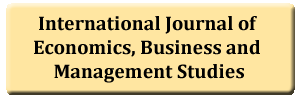Exchange Rate Dynamics and Sectoral Output in Nigeria: A Symmetric and Asymmetric Approach
DOI:
https://doi.org/10.20448/801.51.178.193Keywords:
ARDL, NARDL, Exchange rate, Sectoral output, Nigeria.Abstract
This study examined the symmetric and asymmetric effects of exchange rate dynamics on the performance of the agricultural, industrial and services sector of Nigeria using the ARDL and NARDL frameworks as well annual time-series data sourced from the Central Bank of Nigeria (CBN) Statistical Bulletin over the period of 1981-2016. The results of the short-run linear ARDL model reveal that exchange rate dynamics stimulates the performance of the agricultural and services sector of Nigeria while those of the nonlinear ARDL depict that exchange rate dynamics (depreciation and appreciation) is positively related to agricultural and services sector output but inversely related to industrial output. The result also showed that exchange rate dynamics has no asymmetric impact on sectoral performance which implies that positive and negative exchange rate movement have the same impacts on sectoral output both in the short-run and long-run. Therefore, this study recommended that the Nigerian government ensure adequate exchange rate management to encourage domestic investors and attract foreign investors to the various sectors of the Nigerian economy.




